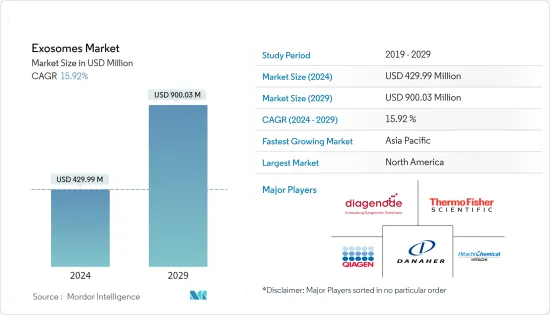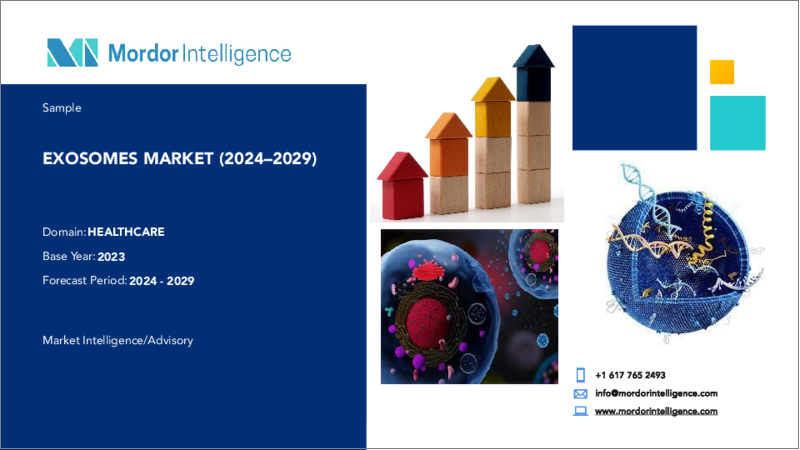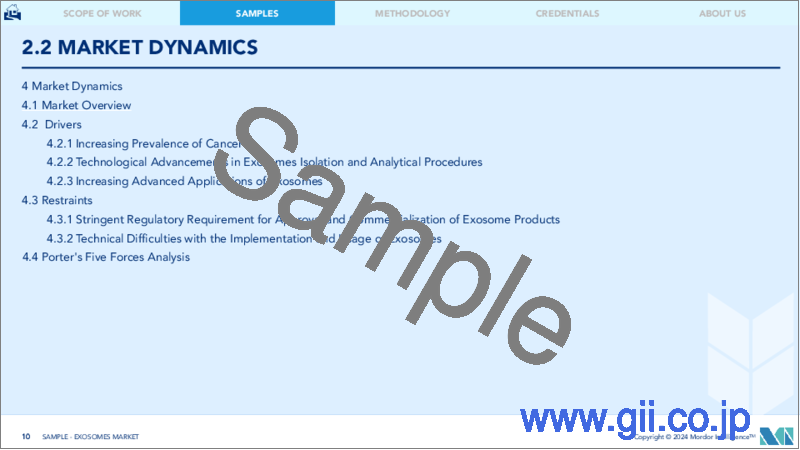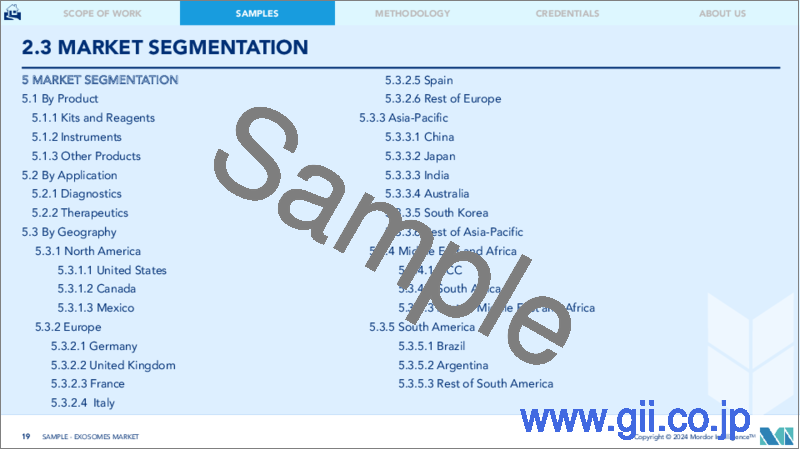|
|
市場調査レポート
商品コード
1444436
エクソソームの世界市場:市場シェア分析、産業動向・統計、成長予測(2024~2029年)Exosomes - Market Share Analysis, Industry Trends & Statistics, Growth Forecasts (2024 - 2029) |
||||||
カスタマイズ可能
適宜更新あり
|
|||||||
| エクソソームの世界市場:市場シェア分析、産業動向・統計、成長予測(2024~2029年) |
|
出版日: 2024年02月15日
発行: Mordor Intelligence
ページ情報: 英文 118 Pages
納期: 2~3営業日
|
- 全表示
- 概要
- 目次
世界のエクソソームの市場規模は、2024年に4億2,999万米ドルに達し、2024~2029年の予測期間中にCAGR 15.92%で成長し、2029年までに9億3万米ドルに達すると予測されております。

COVID-19のパンデミック中、エクソソームの需要が高まりました。エクソソームは、いくつかの病理学的状態に関与する30~120 nmの細胞外小胞です。ウイルスに感染した細胞は、ウイルス由来のmiRNAやタンパク質などのウイルス成分を移入することにより、感染に関与しているエクソソームを放出します。エクソソームには、レシピエント細胞をウイルス侵入しやすくするウイルスの受容体も含まれています。膜貫通プロテアーゼセリン2(TMPRSS2)によるスパイクタンパク質の切断は、アンジオテンシン変換酵素 2(ACE2)受容体との相互作用を介したCOVID-19の侵入と感染に必要です。エクソソームがACE2を受容細胞に転送するという証拠があり、COVID-19の内部移行と感染を支援する機能があることが示唆されています。 2022年1月に国立衛生研究所が発表した研究では、COVID-19は、体内でのウイルスの出現と拡散という点でエクソソームと直接的な関係があることが示唆されています。さらに、肺関連自己抗原、ウイルス抗原、および20Sプロテアソームを運ぶ循環エクソソームが、COVID-19感染者でより蔓延していることが観察されています。したがって、上記の要因により、COVID-19のパンデミックがエクソソーム市場に大きな影響を与えたことは注目に値します。しかし、パンデミック後、エクソソームの研究と調査は、その応用範囲の拡大とともに進化しました。
市場の成長を促進する特定の要因には、がんの罹患率の増加、エクソソームの単離および分析手順における技術の進歩、エクソソームの高度な応用の増加などが含まれます。がん患者の増加は、エクソソームの需要の増加に直接影響を与えます。 GLOBOCAN 2020レポートによると、1,929万人ががんとともに生きており、この数は今後20年間で世界中で増加すると予想されています。がんの症例数が増加しているため、がんへの対処におけるエクソソームの応用性は高いと考えられており、市場の成長に貢献すると予想されます。
牛乳から抽出されたエクソソームは、肺がんや乳がんに対する治療分子を送達するために使用されます。身体の特定の部位に由来するエクソソームは、その強化された受動的ターゲティング、サイズの小ささ、固有の性質、および生物学的障壁を通過する能力により、抗がんワクチンの有望な候補です。したがって、病院でのがん症例の増加は、治療だけでなく診断におけるエクソソームの需要を直接的に増加させます。
ただし、さまざまな用途でエクソソームを正常に実装するには、多くの技術的問題に対処する必要があります。これは、エクソソーム市場の成長に対する主な障害の1つです。主な困難には、精製の最適化、エクソソームの均一性の向上、効率的なトランスフェクション戦略などがあります。さらに、技術情報(ローターの種類、直径、体積、サンプルの粘度など)が不足しているため、エクソソームの最大限の利用が制限されます。
単離および精製方法の煩雑な性質、および免疫系の理解が不完全では異なるがんの段階を区別できないことにより、エクソソーム市場が制限される可能性があります。さらに、この市場の成長を制限する他の要因は、エクソソーム製品の承認と商品化に対する厳しい規制要件です。
エクソソームの市場動向
治療用途セグメントは、エクソソーム市場で最大の市場シェアを保持すると予想されます
エクソソームは、COVID-19を含むさまざまな病気の治療プラットフォームとして使用できる可能性があります。エクソソームは、免疫拒絶や細胞毒性を回避しながら治療用カーゴ成分を送達することにより、さまざまな疾患や組織再生を治療するための無細胞代替物として臨床応用されています。さらに、幹細胞由来のエクソソームは、親細胞の抗炎症能力と再生能力を利用するのに有利です。したがって、エクソソーム治療は、SARS-CoV-2を含む呼吸器ウイルス疾患に対して設計することができます。
エクソソームは、天然物質の輸送特性、本質的な長期循環をサポートする能力、および高い生体適合性を備えているため、ドラッグデリバリーの媒体として有望な可能性を秘めています。これらは、さまざまなタンパク質、化学物質、化学物質の送達に最適な要素です。そして核酸。いくつかの調査研究によると、エクソソームは細胞間コミュニケーションのメディエーターとして肯定的な結果を生み出し、機能性タンパク質、mRNA転写物、miRNAを全身の細胞に届ける可能性があります。一部の種類の細胞(樹状幹細胞や間葉系幹細胞など)に由来するエクソソームは、潜在的な治療特性を備えており、臓器損傷や心臓、腎臓、肝臓、肺の病気などのさまざまな疾患に対して生体適合性があり、効果的な薬剤です。
エクソソーム応用の調査は急速に進歩していますが、エクソソームベースの治療薬の開発、特にエクソソーム製剤の生産性の低さと不均一性のため、多くの課題があります。さらに、エクソソーム製剤の保存、最適化、単離方法にはいくつかの障壁があります。
北米が市場を独占しており、予測期間中にも同様のことが予想される
COVID-19のパンデミック中、米国は世界で最も大きな被害を受けた国でした。エクソソームと細胞外小胞は感染、再感染、再活性化の潜在的なメディエーターであると考えられているため、エクソソームに関する研究の増加は北米市場の成長にプラスの影響を与えています。
北米地域は、より優れたヘルスケアインフラ、効果的な政府政策、多国籍企業の巨大な基盤、および診断とヘルスケアに対する人々の高い意識により、エクソソーム市場で最大のシェアの1つを保持しています。黒色腫、乳がん、肺がん、膵臓がんなど、数種類のがんにおけるエクソソームを使用した薬剤の役割に関して、政府の資金提供により多くの調査研究が実施されています。 MerckやExosome Diagnosticなどの企業は、エール大学やミシガン州立大学などのいくつかの大学を後援し、協力して米国で臨床試験を実施しています。さらに、これらのベンチャーは政府の資金によって非常に手厚くサポートされています。研究は主に新生物に対して行われました。
エクソソーム市場に参入する新技術が市場の成長を促進しています。例えば、2022年7月のLab on Chip Journal出版物によると、米国では、標的特異的単離から免疫調節に至るまで、免疫腫瘍学における細胞外小胞の新興マイクロナノテクノロジーが幅広く採用されています。新しいテクノロジーの採用により、調査対象の市場は今後数年間で大きな成長を遂げると予想されます。
エクソソーム産業の概要
エクソソーム市場は競争が激しく、多数の大手企業で構成されています。 Danaher(Beckman Coulter Inc.)、Diagenode Inc.、Fujifilm Holdings Corporation、Hitachi Chemical Diagnostics Inc.、Lonza、MBL International、Miltenyi Biotec、Novus Biologicals、Qiagen、Thermo Fisher Scientific Inc.などの企業は、エクソソーム市場における大きな市場シェアを保有しています。
その他の特典
- エクセル形式の市場予測(ME)シート
- 3か月のアナリストサポート
目次
第1章 イントロダクション
- 調査の前提条件と市場の定義
- 調査範囲
第2章 調査手法
第3章 エグゼクティブサマリー
第4章 市場力学
- 市場概要
- 市場促進要因
- がんの罹患率の増加
- エクソソームの単離と分析手順における技術の進歩
- 増加するエクソソームの高度な応用
- 市場抑制要因
- エクソソーム製品の承認と商品化のための厳しい規制要件
- エクソソームの実装と使用における技術的困難
- ポーターのファイブフォース分析
- 新規参入業者の脅威
- 買い手の交渉力
- 供給企業の交渉力
- 代替製品の脅威
- 競争企業間の敵対関係の激しさ
第5章 市場セグメンテーション
- 製品別
- キット・試薬
- 機器
- その他の製品
- 用途別
- 診断
- 治療学
- 地域
- 北米
- 米国
- カナダ
- メキシコ
- 欧州
- ドイツ
- 英国
- フランス
- イタリア
- スペイン
- その他の欧州
- アジア太平洋
- 中国
- 日本
- インド
- オーストラリア
- 韓国
- その他のアジア太平洋
- 中東・アフリカ
- GCC
- 南アフリカ
- その他の中東・アフリカ
- 南米
- ブラジル
- アルゼンチン
- その他の南米
- 北米
第6章 競合情勢
- 企業プロファイル
- Danaher Corporation(Beckman Coulter Inc.)
- Hologic Inc.
- Fujifilm Holdings Corporation
- Lonza Group Ltd
- JSR Corporation(MBL International)
- Miltenyi Biotec
- Bio-Techne(Novus Biologicals)
- Qiagen
- Thermo Fisher Scientific Inc.
- Illumina Inc.
- Takara Bio Inc.
- Malvern Instruments Ltd
- Abcam PLC
- Evox Therapeutics
- Capricor Therapeutics Inc.
第7章 市場機会と将来の動向
The Exosomes Market size is estimated at USD 429.99 million in 2024, and is expected to reach USD 900.03 million by 2029, growing at a CAGR of 15.92% during the forecast period (2024-2029).

During the COVID-19 pandemic, there was a rising demand for exosomes. Exosomes are 30-120 nm extracellular vesicles that participate in several pathological conditions. Virus-infected cells release exosomes that are implicated in infection by transferring viral components such as viral-derived miRNAs and proteins. Exosomes also contain receptors for viruses that make recipient cells susceptible to virus entry. The spike protein cleavage by transmembrane protease serine 2 (TMPRSS2) is needed for COVID-19 virus entry and infection via interaction with the angiotensin-converting enzyme 2 (ACE2) receptor. There is evidence that exosomes transfer ACE2 to receipt cells, suggesting a supportive function for COVID-19 virus internalization and infection. A study published by the National Institute of Health in January 2022 suggests that the COVID-19 infection has a direct connection with exosomes in terms of the emergence of the virus inside the body and its spread. Additionally, it is observed that circulating exosomes carrying lung-associated self-antigens, viral antigens, and the 20S proteasome are more prevalent in individuals with coronavirus infection. Hence, with the above-mentioned factors, it is noticeable that the COVID-19 pandemic had a significant impact on the exosome market. However, post-pandemic, exosome study and research have evolved with their widening applications.
Certain factors that are driving market growth include the increasing prevalence of cancer, technological advancements in exosome isolation and analytical procedures, and increasing advanced applications of exosomes. The growing prevalence of cancer patients directly impacts the increased demand for exosomes. According to the GLOBOCAN 2020 report, 19.29 million people are living with cancer, and this number is expected to rise over the next two decades across the globe. With the rising number of cancer cases, it is believed that the application of exosomes in coping with cancer would be high, which is expected to contribute to the market growth.
Exosomes extracted from cow's milk are used to deliver therapeutic molecules against lung and breast cancer. Exosomes derived from specific sites of the body are promising candidates for anti-cancer vaccines due to their enhanced passive targeting and their small size, indigenous nature, and ability to cross biological barriers. Thus, the increase in the number of cancer cases in hospitals directly increases the demand for exosomes in diagnosis as well as therapeutics.
However, many technical difficulties need to be addressed to successfully implement exosomes in various applications. This is one of the primary hindrances to the growth of the exosome market. Some of the major difficulties include optimization of purification, increasing the homogeneity of exosomes, and efficient transfection strategies. This is further accompanied by a lack of technical information (like the type of rotor, diameter, volume, and viscosity of the sample), which restricts the maximum utilization of exosomes.
The cumbersome nature of the methods for isolation and purification and the inability to distinguish between different cancer stages with an incomplete understanding of the immune system may limit the exosome market. Moreover, other factors limiting the growth of this market are the stringent regulatory requirements for the approval and commercialization of exosome products.
Exosome Market Trends
The Therapeutic Application Segment is Expected to Hold the Largest Market Share in the Exosomes Market
Exosomes have the potential to be used as a therapeutic platform for a variety of diseases, including COVID-19. Exosomes have clinical applications as cell-free alternatives for treating various diseases and tissue regeneration by delivering therapeutic cargo components while avoiding immune rejection and cellular toxicity. In addition, stem cell-derived exosomes are advantageous in harnessing the anti-inflammatory and regenerative abilities of parent cells; thus, exosomal treatment can be engineered for respiratory viral diseases, including SARS-CoV-2.
Exosomes have promising potential to be a vehicle for drug delivery as they have natural material transportation properties, the capability to support intrinsic long-term circulation, and high biocompatibility, which are the most suitable factors for the delivery of a variety of proteins, chemicals, and nucleic acids. According to a few research studies, exosomes have generated positive results as mediators of intercellular communication, potentially delivering functional proteins, mRNA transcripts, and miRNAs to cells throughout the body. Exosomes, derived from some types of cells (such as dendritic and mesenchymal stem cells), have potential therapeutic properties and are biocompatible and efficient agents against various disorders, such as organ injury and various disorders including heart, kidney, liver, and lung illnesses.
Although there has been rapid progress in the research of exosome applications, there are many challenges in the development of exosome-based therapeutics, particularly in the production of exosome formulations due to their low productivity and heterogeneity. Moreover, there are a few barriers in the storage, optimization, and isolation methods of exosome formulations.
North America Dominates the Market and is Expected to do the Same in the Forecast Period
During the COVID-19 pandemic, the United States was the most affected country in the world. As exosomes and extracellular vesicles are considered potential mediators of infection, reinfection, and reactivation, the growing number of studies concerning exosomes is positively impacting market growth in North America.
The North American region holds one of the largest shares in the exosome market, owing to better healthcare infrastructure, effective government policies, a huge base of multinational companies, and high awareness among people about diagnostics and healthcare. Many government-funded research studies have been conducted regarding the role of drugs using exosomes in several kinds of cancer, such as melanoma, breast cancer, lung cancer, and pancreatic cancer, among others. Companies like Merck and Exosome Diagnostic have sponsored and collaborated with several universities, such as Yale University and Michigan State University, to conduct clinical trials in the United States. Furthermore, these ventures are very well supported by government funding. The studies were mostly conducted for neoplasms.
New technologies coming into the exosome market are fueling market growth. For instance, according to the Lab on Chip Journal publication of July 2022, the United States is experiencing wide adoption of emerging micro-nanotechnologies for extracellular vesicles in immuno-oncology ranging from target-specific isolations to immunomodulation. With the adoption of new technologies, the market studied is expected to witness strong growth in the coming years.
Exosome Industry Overview
The exosome market is highly competitive and consists of a number of major players. Companies like Danaher (Beckman Coulter Inc.), Diagenode Inc., Fujifilm Holdings Corporation, Hitachi Chemical Diagnostics Inc., Lonza, MBL International, Miltenyi Biotec, Novus Biologicals, Qiagen, and Thermo Fisher Scientific Inc., among others, hold a substantial market share in the exosomes market.
Additional Benefits:
- The market estimate (ME) sheet in Excel format
- 3 months of analyst support
TABLE OF CONTENTS
1 INTRODUCTION
- 1.1 Study Assumptions and Market Definition
- 1.2 Scope of the Study
2 RESEARCH METHODOLOGY
3 EXECUTIVE SUMMARY
4 MARKET DYNAMICS
- 4.1 Market Overview
- 4.2 Market Drivers
- 4.2.1 Increasing Prevalence of Cancer
- 4.2.2 Technological Advancements in Exosome Isolation and Analytical Procedures
- 4.2.3 Increasing Advanced Applications of Exosomes
- 4.3 Market Restraints
- 4.3.1 Stringent Regulatory Requirements for Approval and Commercialization of Exosome Products
- 4.3.2 Technical Difficulties with the Implementation and Usage of Exosomes
- 4.4 Porter's Five Forces Analysis
- 4.4.1 Threat of New Entrants
- 4.4.2 Bargaining Power of Buyers/Consumers
- 4.4.3 Bargaining Power of Suppliers
- 4.4.4 Threat of Substitute Products
- 4.4.5 Intensity of Competitive Rivalry
5 MARKET SEGMENTATION (Market Size by Value - USD million)
- 5.1 By Product
- 5.1.1 Kits and Reagents
- 5.1.2 Instruments
- 5.1.3 Other Products
- 5.2 By Application
- 5.2.1 Diagnostics
- 5.2.2 Therapeutics
- 5.3 Geography
- 5.3.1 North America
- 5.3.1.1 United States
- 5.3.1.2 Canada
- 5.3.1.3 Mexico
- 5.3.2 Europe
- 5.3.2.1 Germany
- 5.3.2.2 United Kingdom
- 5.3.2.3 France
- 5.3.2.4 Italy
- 5.3.2.5 Spain
- 5.3.2.6 Rest of Europe
- 5.3.3 Asia-Pacific
- 5.3.3.1 China
- 5.3.3.2 Japan
- 5.3.3.3 India
- 5.3.3.4 Australia
- 5.3.3.5 South Korea
- 5.3.3.6 Rest of Asia-Pacific
- 5.3.4 Middle East and Africa
- 5.3.4.1 GCC
- 5.3.4.2 South Africa
- 5.3.4.3 Rest of Middle East and Africa
- 5.3.5 South America
- 5.3.5.1 Brazil
- 5.3.5.2 Argentina
- 5.3.5.3 Rest of South America
- 5.3.1 North America
6 COMPETITIVE LANDSCAPE
- 6.1 Company Profiles
- 6.1.1 Danaher Corporation (Beckman Coulter Inc.)
- 6.1.2 Hologic Inc.
- 6.1.3 Fujifilm Holdings Corporation
- 6.1.4 Lonza Group Ltd
- 6.1.5 JSR Corporation (MBL International)
- 6.1.6 Miltenyi Biotec
- 6.1.7 Bio-Techne (Novus Biologicals)
- 6.1.8 Qiagen
- 6.1.9 Thermo Fisher Scientific Inc.
- 6.1.10 Illumina Inc.
- 6.1.11 Takara Bio Inc.
- 6.1.12 Malvern Instruments Ltd
- 6.1.13 Abcam PLC
- 6.1.14 Evox Therapeutics
- 6.1.15 Capricor Therapeutics Inc.






